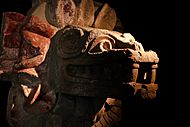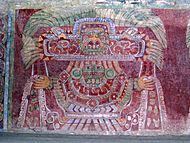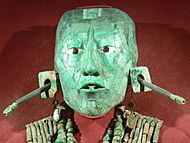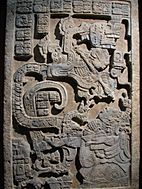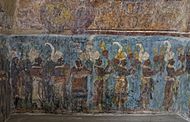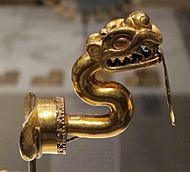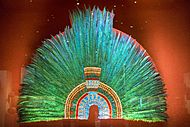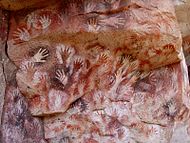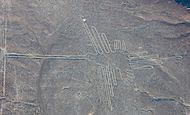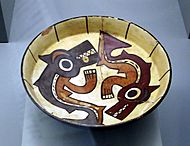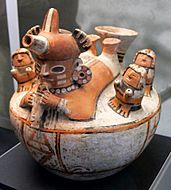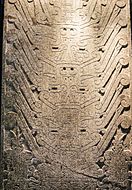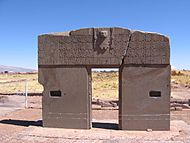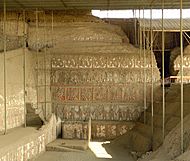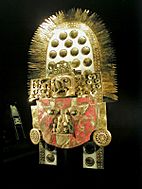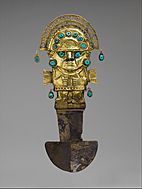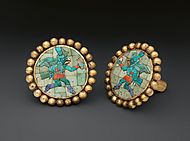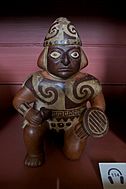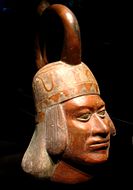Pre-Columbian art facts for kids
Pre-Columbian art is the amazing art made by the native peoples of the Americas. This includes areas like the Caribbean, North America, Central America, and South America. This art was created from about 13,000 BCE until Europeans arrived in the late 1400s and early 1500s.
Sadly, many artworks made from materials like cloth have not survived. But we still have many incredible pieces. These include large stone sculptures, gold objects, pottery, and paintings on walls and rocks.
When Europeans first arrived, they saw the art of the Inca and Aztecs. Some of these artworks were even taken back to Europe. Later, people discovered the art of older civilizations that had already fallen. These include the Maya and Olmec cultures. Their huge stone sculptures became very famous.

Many Pre-Columbian cultures did not have writing. So, their art was a way to share their beliefs, religion, and ideas about the world. Artists used many different materials. These included obsidian (a type of volcanic glass), gold, and spondylus shells. They believed these materials had special meanings.
These cultures often valued the materials and how well something was made. They also liked rare materials. Many artworks have been found far from where they were made. This shows that these ancient civilizations traded and connected with each other. Art was also seen as a link to the gods and spirits. Because spirituality was so important, artworks often showed gods and religious ceremonies.
Contents
Art from Mesoamerica and Central America
Mesoamerica is a historical region that includes parts of Mexico and Central America. The cultures here are usually divided into three main time periods:
- Pre-classic period (before 200 CE)
- Classic period (around 200–900 CE)
- Post-classic period (around 900 to 1580 CE)
Pre-classic Period: The Olmecs
The Olmec civilization was very advanced during the Pre-classic period. They lived from about 1200–400 BCE. The Olmecs made small jade statues. They are most famous for their huge, mysterious colossal heads. These giant stone heads can be up to 2 meters (6.5 feet) tall. They still stand in the landscape today. The Olmecs also started the tradition of building large ceremonial centers.
Classic Period: The Maya
During the Classic period, the Maya were the most powerful. Maya kings and queens ordered artworks to remember their achievements. These artworks showed rituals and historical events. They often included hieroglyphic writing. This writing helped people know who was in the picture, when it happened, and where.
Understanding these hieroglyphs is very important. It helps us learn about the powerful rulers of the Maya civilization. Like some groups in North America, the Maya lived in large farming communities. They had their own writing system and were skilled in astronomy. Maya art often focused on rain, farming, and fertility. They showed these ideas in carvings and decorations on buildings.
Glyphs and stylish figures decorated buildings like the pyramid temple of Chichén Itzá. Amazing murals (wall paintings) from around 750 CE were found when the city of Bonampak was discovered in 1946.
Post-classic Period: Toltecs, Mixtecs, and Aztecs
The Post-classic period (10th–12th centuries) was led by the Toltecs. They made huge, block-like sculptures. Some of these were used as columns at Tula, Mexico.
The Mixtecs developed a painting style called Mixtec-Puebla. You can see it in their murals and codices (ancient books). Every bit of space is filled with flat figures and geometric designs.
The Aztec culture in Mexico created very powerful artworks. These include decorated skulls of captives and stone sculptures. One famous example is Tlazolteotl, a goddess shown giving birth. Aztec art, like other Mesoamerican cultures, often focused on worshipping gods. They also showed important values of their society.
The Aztecs also liked to make their art look very real. They believed that life-like art helped convey their message better. For example, the Eagle Warrior statues are life-sized ceramic sculptures. They show the Aztec value of youthful beauty. You can see this in the warrior's young and soft facial features.
-
Feathered serpent sculpture in Teotihuacan
-
Mortuary mask of K'inich Janaab' Pakal
-
Stele H, Copán
-
Lintel 25, Yaxchilan
-
Zapotec mosaic mask of a Bat god, made of 25 pieces of jade. It was found in a tomb at Monte Albán.
-
Serpent labret with articulated tongue, in the Metropolitan Museum of Art
-
Codex Borgia page 56, showing Mictlāntēcutli and Quetzalcoatl
-
Feather headdress of Moctezuma II
Art from South America
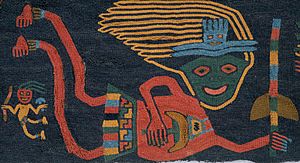
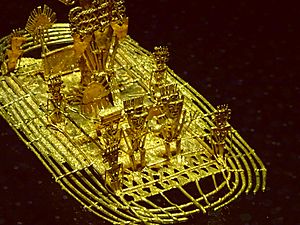
In the central Peruvian Andes mountains, the Chavín civilization thrived from about 1000 BCE to 300 BCE. The Chavín made small pottery pieces. These often looked like humans but had animal parts, such as bird feet or feline fangs. Images of jaguars were very common in Chavín art. The Chavín culture is also known for the amazing murals and carvings found at their main religious site, Chavín de Huantar. These include the Raimondi Stele, the Lanzón, and the Tello Obelisk.
Paracas and Nazca Cultures
Around the same time as the Chavín, the Paracas culture lived on the southern coast of Peru. They are most famous for their detailed textiles (woven fabrics). Some of these incredible pieces were 90 feet long! They were mainly used to wrap mummy bundles for burial. Paracas art was much like Chavín art, sharing many similar designs.
After the Paracas, the Nazca culture flourished near the Nazca river valley. The Nazca period is divided into eight phases based on their pottery. Their pottery designs became more abstract over time. The Nazca people are most famous for the mysterious Nazca Lines. These are huge drawings on the desert floor. They also made some of the most beautiful colorful pottery in the Andes.
Moche Culture
On the north coast, the Moche followed the Chavín. The Moche lived from about 100–800 CE. They were some of the best artists in the Pre-Columbian world. They made wonderful portrait vases. These vases looked very real but had religious meanings that are now lost. For the Moche, pottery was a main way to share information and cultural ideas. Moche ceramic vessels showed many things: fruits, plants, animals, human faces, gods, and demons. The Moche were also skilled in working with metals, like the gold found in the tomb of the Lord of Sipán. They were also great builders, creating structures like the Huaca de la Luna and the Huaca del Sol.
Wari and Tiwanaku Empires
After the Moche declined, two large empires appeared in the Andes. In the north, the Wari (or Huari) Empire was based in its capital city. The Wari were known for their stone buildings and sculptures. But their best skill was pottery. The Wari made magnificent large ceramics. Many showed the Staff God, an important deity in the Andes.
The Wari's neighbors, the Tiwanaku empire, were also centered around a capital city of the same name. They also honored the Staff God. Tiwanaku's empire began to grow around 400 BCE. Their "Classic Period" of art and power was between 375 and 700 CE. Tiwanaku is famous for its grand city on the southern side of Lake Titicaca, in modern-day Bolivia. The Gate of the Sun is especially famous. It shows a large image of the Staff God with other religious symbols. These symbols might have worked as a calendar.
Chimú and Inca Empires
After the Wari Empire declined, the Chimú people started building their empire. They were based in their capital city of Chimor on the north and central coasts of Peru. The Chimú made excellent portrait and decorative works in metal, especially silver and gold. They were also known for their featherwork. They made many standards and headdresses from colorful tropical feathers. These often showed bird and fish designs, which were important to the Chimú. The Chimú are best known for their amazing palace complex of Chan Chan. This is now a UNESCO World Heritage Site. The Chimú empire declined quickly because of the expanding Inca Empire in the mid-1400s.
At the time of the Spanish conquest, the Inca Empire (called Tawantinsuyu in Quechua) was the largest and richest empire in the world. Their art showed this wealth. Most Inca gold sculptures were melted down by the Spanish. So, what remains today is mostly architecture, textiles, and pottery. The Inca valued gold above all other metals. They linked it to the sun god Inti. Some Inca buildings in the capital of Cusco were covered in gold. Many also had gold and silver sculptures.
Most Inca art, however, was abstract, meaning it used shapes and patterns. Inca pottery was mainly large vessels with geometric designs. Inca tunics (clothing) and textiles had similar patterns. Checkerboard patterns were often used for the Inca elite and army. Today, the Inca are best known for their architecture. This includes the famous complex of Machu Picchu near Cusco.
Inca architecture uses large stone blocks. Each stone was cut perfectly to fit with the others in a wall. They were cut so precisely that the Incas did not need mortar to hold their buildings together. Even without mortar, Inca buildings still stand today. Many modern buildings in Cusco are built on Inca foundations. The Incas built thousands of large stone structures. These included forts, temples, and palaces. This is amazing because the Inca Empire only lasted for 95 years.
-
Cueva de las Manos in Argentina. The art here dates back 13,000–9,000 years.
-
Recuay culture ceramic.
-
Raimondi Stele from the Chavín culture.
-
A Tumi (ceremonial knife).
-
Feather headdress of the Amazonic cultures.
See also
 In Spanish: Arte precolombino para niños
In Spanish: Arte precolombino para niños



